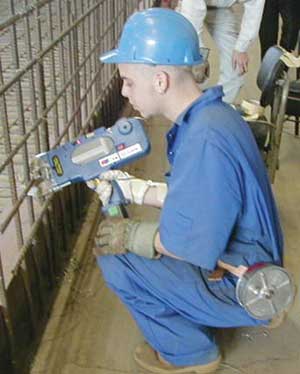|
Rebar-Tying
Machines - Part I (Taken from Construction Safety Magazine,Volume 12, Number 4, Winter 2001/02.) |

|
Peter Vi, Hon. B.Sc. (Ergonomics), Project Coordinator, CSAO
Construction Safety Association of Ontario
An
effective way to reduce upper limb MSIs
Machines require
less force and repetition
At the request of the Rodworkers' Trade Labour-Management Health and Safety
Committee, CSAO conducted a study of rebar-tying tasks during concrete
reinforcement.
Because of the repetitive, often heavy manual material handling required to lift, carry, lower, and install reinforcing steel, rodworkers suffer a high number of musculoskeletal injuries (MSIs).
MSIs are injuries of the muscles, nerves, tendons, ligaments, joints, cartilage, and spinal discs. Typically they are non-traumatic, that is, caused not by sudden accidents such as trips or slips but by overexertion and repetition over time.
Purpose
The main purpose of CSAO's study was to evaluate the risks of upper limb
injury (such as elbow, arm and hand) and the benefits of using rebar-tying
machines. The photo shows the use of a rebar gun.
Rebar-tying tasks were evaluated using an electro-goniometer (to measure wrist angles) and force sensor tape (to measure hand and grip forces). Seven rodworker apprentices and one instructor took part in the research.

Results
The study revealed that working with rebar-tying guns required significantly
less handgrip force than manual tying. Moreover, the number of hand repetitions
was significantly lower when participants used the guns.
Results indicate that rebar-tying machines can have a positive benefit in preventing MSIs to the upper limbs.
The machines also allow workers to work upright and thus avoid the bending, twisting, and awkward static trunk posture of manual tying at ground level.
In addition, working with rebar-tying guns requires only one hand. Workers can lean on their knee with the other hand and thereby support their trunk. This in turn decreases some of the muscle activity and muscle fatigue that occur with manual tying.
Summary
Rodworkers have a high rate of lost-time MSIs caused in part by static
awkward posture during manual tying and by repeated and often heavy material
handling.
One way to decrease these risks is to use automatic rebar-tying machines. CSAO research indicates that these machines can help to decrease hand-grip force and repetitive wrist motions such as bending, twisting, flexion, and extension.
Future
Research
In a future issue, CSAO will report the results of a study that evaluates
the potential benefits of reducing low-back injury by using rebar-tying
machines.
This paper appears in the eLCOSH website with the permission of the author and/or copyright holder and may not be reproduced without their consent. eLCOSH is an information clearinghouse. eLCOSH and its sponsors are not responsible for the accuracy of information provided on this web site, nor for its use or misuse.
